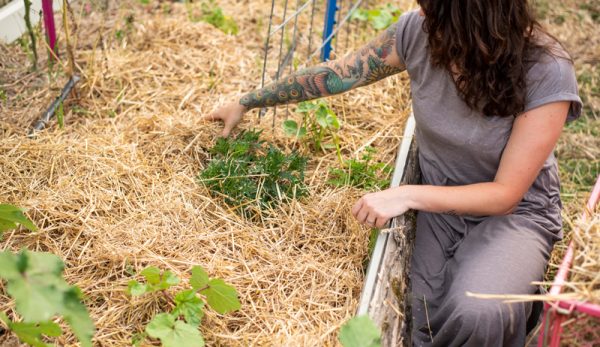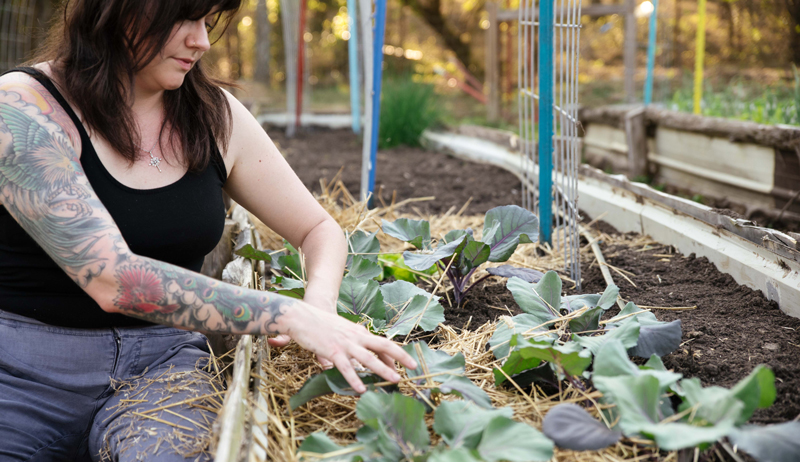
Excerpted from “The First-Time Gardener: Growing Vegetables” by Jessica Sowards of Roots and Refuge Farm. Available March 2, 2o21, from QuartoKnows.

What you decide to use to mulch your garden will likely be influenced by your region, budget and the availability of materials.
Here are some common options used to cover garden soil:
Wood Chips
There are entire gardening methods developed around mulching with woods chips. Wood chips are often an economical choice because they can be obtained for free from tree services that will dump a pile of freshly shredded trees at your house. They take at least a season to break down to the point of being usable and are very labor-intensive to move into place. They do add a tremendous amount of nitrogen to the soil as they deteriorate and provide a very solid covering but should be used with awareness and education. Putting wood chips on the garden before they are broken down, especially mixing them into the soil, can cause severe imbalances in the soil and cause plants to suffer.
Leaf Mulch
Fallen leaves can be raked into compost piles in the fall and used to mulch the gar-den in the spring. They are best used as mulch once they have be-gun to break down, or once they have been shredded. When used whole and freshly fallen, they can provide too much of a barrier, blocking the soil from receiving the moisture it needs. They have the benefit of adding nu-trients to the soil as they decompose.
Compost
Compost is a fantastic covering for the organic garden. Spreading a 2- to 3-inch (5 to 7.6 cm) layer of compost will help build soil structure, hold moisture, and feed the soil with organic nutrients. Because compost can be loose, you may want to add a thin layer of straw or wood chips on top of the compost for weed suppression. Compost can be made at home or purchased.
Straw
Straw is the by-product of processing cereal grains like barley, rye, or wheat. Removing the grain and chaff leaves behind the hollow stalks of the grain stem—the straw. Straw is typically sold as animal bedding because it has no nutritional value. Mulching with straw doesn’t add much organic material back to the garden, making it a good option to mulch on top of compost or with some other organic matter. It’s slower to break down and is a fantastic insulator. Due to its hollow nature, it helps protect the soil from temperature extremes and is a good option for fall and winter gardening or gardening in very warm climates.

Hay
A thick layer of hay mulch can do a lot for a garden. Hay is a grass, legume, or other herbaceous plant that has been cut and dried for animal fodder. Not to be mistaken for hol-low straw, hay is a whole plant and adds a lot of nutrition to your soil as it breaks down. It will compact quicker and break down faster than straw. The downside of hay is that it often has a lot of grass seeds in it. This means that it may bring weeds into the garden, though hay will be very shallowly rooted and is easy to pull, as it grows in the mulch, not the soil. Hay is a good option for very dry areas, as it holds a lot of water.
Woven Ground Cover
This specialty garden product can be found anywhere greenhouses and greenhouse supplies are sold. It is a woven material that is rolled out over the prepared soil and fastened with yard stakes. It is water permeable but blocks the light and, therefore, suppresses weeds. Holes can be measured and cut in whatever spacing is necessary for the crop being grown.
Note: Woven ground cover is popular among market growers and in some situations can be a worthy investment. It is expensive, however, and weeds will grow through the holes. It does not lend to mixing up your garden layout. I use this product and I do like it, but I wouldn’t suggest it for a brand-new gardener.
What Not to Use for Mulch
There are some mulch products available for purchase that are not intended for vegeta-ble gardens.
Rubber
Rubber mulch, which is designed for playgrounds or commercial landscaping, is not a safe product to have at the base of your food plants. It is usually made of recycled tires and will leach toxic chemicals into soil.
Dyed Wood
Dyed wood, often used in commercial landscaping, is coated to actually pre-vent breakdown, meaning it will do the opposite of what you want in your vegetable garden. It will leach possible contaminants into your garden soil, and because it won’t break down, it can kill beneficial soil bacteria and the life in your soil.
Jessica Sowards is a native Arkansan who is homesteading, gardening, and sharing her journey through social media. She and her husband, Jeremiah, are raising their six children on a small hobby farm in the Central Arkansas region. They share their lives on their YouTube channel, Roots and Refuge Farm. Jessica is passionate about gardening, growing food and equipping others to do the same.




